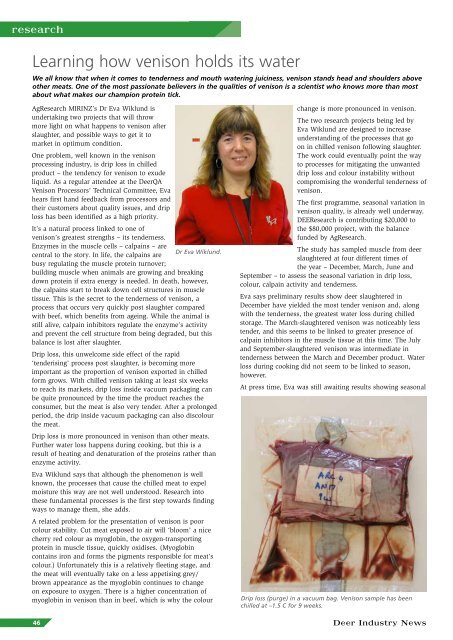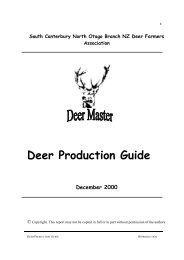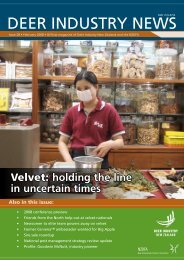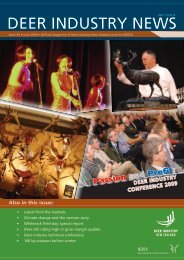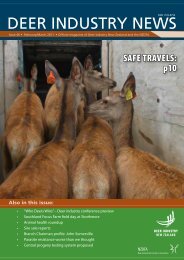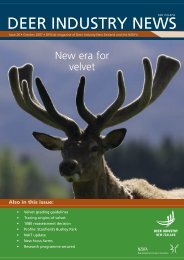Deer Industry News - Deer Industry New Zealand
Deer Industry News - Deer Industry New Zealand
Deer Industry News - Deer Industry New Zealand
You also want an ePaper? Increase the reach of your titles
YUMPU automatically turns print PDFs into web optimized ePapers that Google loves.
esearch<br />
Learning how venison holds its water<br />
We all know that when it comes to tenderness and mouth watering juiciness, venison stands head and shoulders above<br />
other meats. One of the most passionate believers in the qualities of venison is a scientist who knows more than most<br />
about what makes our champion protein tick.<br />
AgResearch MIRINZ’s Dr Eva Wiklund is<br />
undertaking two projects that will throw<br />
more light on what happens to venison after<br />
slaughter, and possible ways to get it to<br />
market in optimum condition.<br />
One problem, well known in the venison<br />
processing industry, is drip loss in chilled<br />
product – the tendency for venison to exude<br />
liquid. As a regular attendee at the <strong>Deer</strong>QA<br />
Venison Processors’ Technical Committee, Eva<br />
hears first hand feedback from processors and<br />
their customers about quality issues, and drip<br />
loss has been identified as a high priority.<br />
It’s a natural process linked to one of<br />
venison’s greatest strengths – its tenderness.<br />
Enzymes in the muscle cells – calpains – are<br />
Dr Eva Wiklund.<br />
central to the story. In life, the calpains are<br />
busy regulating the muscle protein turnover;<br />
building muscle when animals are growing and breaking<br />
down protein if extra energy is needed. In death, however,<br />
the calpains start to break down cell structures in muscle<br />
tissue. This is the secret to the tenderness of venison, a<br />
process that occurs very quickly post slaughter compared<br />
with beef, which benefits from ageing. While the animal is<br />
still alive, calpain inhibitors regulate the enzyme’s activity<br />
and prevent the cell structure from being degraded, but this<br />
balance is lost after slaughter.<br />
Drip loss, this unwelcome side effect of the rapid<br />
‘tenderising’ process post slaughter, is becoming more<br />
important as the proportion of venison exported in chilled<br />
form grows. With chilled venison taking at least six weeks<br />
to reach its markets, drip loss inside vacuum packaging can<br />
be quite pronounced by the time the product reaches the<br />
consumer, but the meat is also very tender. After a prolonged<br />
period, the drip inside vacuum packaging can also discolour<br />
the meat.<br />
Drip loss is more pronounced in venison than other meats.<br />
Further water loss happens during cooking, but this is a<br />
result of heating and denaturation of the proteins rather than<br />
enzyme activity.<br />
Eva Wiklund says that although the phenomenon is well<br />
known, the processes that cause the chilled meat to expel<br />
moisture this way are not well understood. Research into<br />
these fundamental processes is the first step towards finding<br />
ways to manage them, she adds.<br />
A related problem for the presentation of venison is poor<br />
colour stability. Cut meat exposed to air will ‘bloom’ a nice<br />
cherry red colour as myoglobin, the oxygen-transporting<br />
protein in muscle tissue, quickly oxidises. (Myoglobin<br />
contains iron and forms the pigments responsible for meat’s<br />
colour.) Unfortunately this is a relatively fleeting stage, and<br />
the meat will eventually take on a less appetising grey/<br />
brown appearance as the myoglobin continues to change<br />
on exposure to oxygen. There is a higher concentration of<br />
myoglobin in venison than in beef, which is why the colour<br />
46<br />
change is more pronounced in venison.<br />
The two research projects being led by<br />
Eva Wiklund are designed to increase<br />
understanding of the processes that go<br />
on in chilled venison following slaughter.<br />
The work could eventually point the way<br />
to processes for mitigating the unwanted<br />
drip loss and colour instability without<br />
compromising the wonderful tenderness of<br />
venison.<br />
The first programme, seasonal variation in<br />
venison quality, is already well underway.<br />
DEEResearch is contributing $20,000 to<br />
the $80,000 project, with the balance<br />
funded by AgResearch.<br />
The study has sampled muscle from deer<br />
slaughtered at four different times of<br />
the year – December, March, June and<br />
September – to assess the seasonal variation in drip loss,<br />
colour, calpain activity and tenderness.<br />
Eva says preliminary results show deer slaughtered in<br />
December have yielded the most tender venison and, along<br />
with the tenderness, the greatest water loss during chilled<br />
storage. The March-slaughtered venison was noticeably less<br />
tender, and this seems to be linked to greater presence of<br />
calpain inhibitors in the muscle tissue at this time. The July<br />
and September-slaughtered venison was intermediate in<br />
tenderness between the March and December product. Water<br />
loss during cooking did not seem to be linked to season,<br />
however.<br />
At press time, Eva was still awaiting results showing seasonal<br />
Drip loss (purge) in a vacuum bag. Venison sample has been<br />
chilled at –1.5 C for 9 weeks.<br />
<strong>Deer</strong> <strong>Industry</strong> <strong><strong>New</strong>s</strong>


